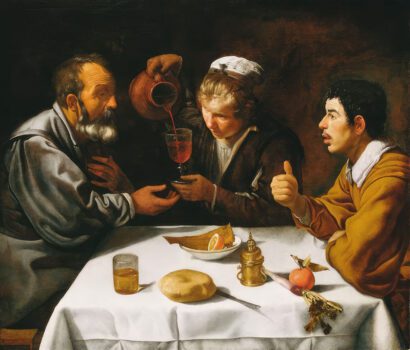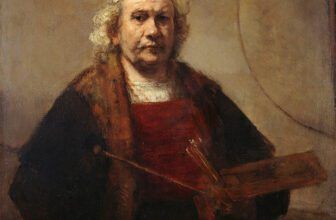Meaning of “The Lunch” Painting by Diego Velázquez
Art often captures the grandeur of myths, the splendor of royalty, or the divine revelations of religious ecstasy. But sometimes, in the hands of a true master, it takes a quiet scene, a simple lunch, some humble peasants, a bottle of wine, and elevates it to something timeless. One such example is “The Lunch” (Spanish: La Merienda), painted around 1617 by Diego Rodríguez de Silva y Velázquez, a Spanish artist who would go on to become one of the most influential painters of all time.
While Velázquez is best known for masterpieces like Las Meninas or The Surrender of Breda, his early bodegón paintings (scenes of daily life with still life elements) offer a unique window into his early genius. “The Lunch” is one such painting. This unassuming yet brilliant canvas reveals not only the artist’s technical prowess but also his deep sensitivity to human life in its most mundane, relatable moments.
The Artist Behind the Canvas: Diego Velázquez
Before analyzing The Lunch, it’s essential to understand where Velázquez was in his life and career when he painted it.
Born in Seville in 1599, Velázquez was immersed in a cultural milieu rich with artistic tradition and economic exchange. Seville was a bustling port city, thriving from its trade with the New World. At the age of 11, he began studying under Francisco Pacheco, a painter and theorist who became both mentor and father-in-law to Velázquez. Under Pacheco’s guidance, Velázquez was exposed to a variety of artistic influences, including Caravaggio’s dramatic use of light and shadow (chiaroscuro), the realism of Flemish art, and the discipline of classical techniques.
The Lunch was painted when Velázquez was around 18 years old, making it one of his earliest known independent works. Despite his youth, the painting demonstrates a precocious mastery of form, light, and narrative, hallmarks of the mature Velázquez that would later shine through in his royal portraits and historical compositions.
What Is “The Lunch” Painting About?
At first glance, The Lunch may seem like an ordinary genre scene. The painting portrays three men seated around a table, enjoying a modest meal. A bottle of wine, a loaf of bread, and some fish are arranged on a wooden table, with a white cloth draped casually over it. One of the men, perhaps a servant or a commoner, lifts a glass as if mid-conversation or in the act of offering a toast. Another, elderly and bearded, listens attentively, while the third looks directly out of the painting, making eye contact with the viewer.
But this is not just a scene of three men eating. It’s a composition filled with subtle interactions, textures, expressions, and symbolism. The figures are not posed artificially, they are captured mid-action, as though the viewer has just stepped into a room to find them talking. The effect is immersive, immediate, and utterly human.
The Art of Realism: A New Language of Painting
The Lunch is classified as a bodegón, a Spanish genre that blends elements of still life and genre painting. These scenes were often set in kitchens or taverns, depicting common people preparing or eating food. Velázquez’s bodegones, however, stood apart from others of the time due to their remarkable realism and psychological depth.
Instead of idealizing his subjects, Velázquez chose to depict the world as he saw it, wrinkles, dirt under fingernails, chipped pottery and all. He wasn’t interested in romanticizing poverty or turning everyday life into allegory; rather, he observed and recorded it with empathy and precision.
In The Lunch, the folds of the tablecloth, the play of light on the wine bottle, the reflections on a glass, the varied textures of bread crust, fish scales, and human skin, each element is rendered with a tactile clarity that demonstrates Velázquez’s astonishing eye for detail and form.
Symbolism and Meaning in “The Lunch”
Although The Lunch is grounded in realism, it’s by no means devoid of symbolism or layered meaning.
1. The Triad of Men
The three figures may represent the three ages of man, youth, maturity, and old age, a theme often explored in European art to reflect on the passage of time and the cycles of life. The younger man (possibly a servant), the middle-aged man pouring wine, and the elderly listener each offer a glimpse into a different stage of existence.
This triadic structure also mirrors religious compositions, such as the Holy Trinity or the biblical Emmaus Supper. However, in Velázquez’s secular and grounded world, these sacred echoes are reinterpreted in earthy, humanistic terms.
2. The Still Life as Memento Mori
The still life elements, the bread, wine, and fish, carry traditional Christian connotations. Bread and wine evoke the Eucharist, while fish is a long-standing symbol of Christ. Yet here, these items are not stylized or glorified. They are placed plainly, suggesting a blending of sacred and profane, or perhaps emphasizing the holiness of everyday life.
Still life in Velázquez’s time also often served as memento mori, reminders of mortality. The simplicity of the food, the age of one of the men, and the transience of the moment together may subtly urge the viewer to reflect on the fleeting nature of life.
What Is Happening in the Scene?
The genius of Velázquez lies in his ability to inject narrative into static forms. Though nothing overtly dramatic happens in The Lunch, the scene is alive with gesture, glance, and suggestion.
The young man raises a glass, perhaps to make a point, toast, or emphasize a story.
The elderly man leans in, eyes focused, listening with quiet intensity.
The third man meets the viewer’s gaze, breaking the fourth wall. His expression is ambiguous: is it welcoming? Curious? Guarded?
This subtle tension invites the viewer to step into the scene. Are we being addressed? Are we interrupting a story? This interactive dynamic makes the painting feel startlingly modern, a hallmark of Velázquez’s narrative intelligence.
Lighting and Composition
Velázquez’s use of tenebrism (strong contrast between light and dark) recalls Caravaggio’s influence. The background is dark, enveloping the scene in a kind of chiaroscuro intimacy, while the figures and objects are illuminated with a gentle but focused light. This creates a spotlight effect, drawing the eye to the essential elements and reinforcing the mood of hushed conversation.
The composition is tight, cropped close around the table, enhancing the feeling of immediacy. The triangular arrangement of the three figures gives the painting visual stability, while the diagonals created by their gestures and gazes introduce dynamic tension.
Why Did Velázquez Paint This?
At the time Velázquez created The Lunch, he was a young artist trying to assert his voice and skill. Bodegones allowed him to demonstrate technical expertise (especially in still life) and to differentiate himself from other artists in Seville.
But more than that, The Lunch speaks to a broader cultural shift in 17th-century Spain. Amid political instability, economic hardship, and intense religious scrutiny, everyday life became a more legitimate subject for contemplation and artistic representation. Velázquez, far from being merely an imitator of foreign models, was a pioneer in giving dignity and psychological weight to scenes of the common man.
This approach aligned with the Spanish Baroque sensibility, stoic, introspective, and grounded in the realities of human experience.
Style and Artistic Movement
The Lunch falls within the Spanish Baroque period, known for its realism, emotional depth, and moral introspection. However, it also reflects elements of naturalism and tenebrism, inspired by the Italian Caravaggisti.
What sets Velázquez apart from many of his contemporaries is his refusal to over-dramatize. While many Baroque painters sought theatricality, Velázquez leaned toward subtlety. His work possesses a quiet gravity, emotional power conveyed through restraint rather than spectacle.
Where Is “The Lunch” Painting Located Today?
Today, The Lunch is housed in the Museum of Fine Arts of Budapest (Szépművészeti Múzeum), Hungary. It remains one of the museum’s highlights and a testament to Velázquez’s youthful genius.
Though lesser-known than his court portraits or large-scale canvases, The Lunch offers art lovers a rare opportunity to witness the embryonic stage of an artist who would later redefine the art of painting. Visitors to the museum often remark on the work’s intimacy and realism, which stand out even among masterpieces from more mature periods.
A Quiet Revolution in Oil
The Lunch by Diego Velázquez may appear modest, even unremarkable, compared to his later royal commissions. But its power lies precisely in its humility. In depicting a simple meal shared among common men, Velázquez revealed profound truths about human connection, transience, and the sanctity of the everyday.
The painting represents an early flowering of the artist’s genius, his eye for detail, his gift for narrative, his respect for realism, and his subtle sense of symbolism. In its silence, it speaks volumes.
More than four centuries later, The Lunch continues to resonate not just because it is beautifully painted, but because it captures something universal. In every loaf of bread, every conversation across a table, every fleeting human moment, there is a story waiting to be seen, and in Velázquez’s hands, a masterpiece waiting to be made.




